SUNDRE – Combatting ageism begins with a willingness to confront our own biases.
This was among the key takeaway messages presented by a speaker who addressed the issue on Tuesday, June 3 during the second annual seniors fair at the Sundre Community Centre.
The Sundre Seniors Protected and Respected Under Community Engagement (S.P.R.U.C.E.) group organized the event, which also included other presentations on topics such as emergency preparedness and understanding what benefits seniors are entitled to, as well as a variety of vendors and exhibitors with 26 tables set up.
The Sundre Community Van Society provided several residents of the Sundre Seniors’ Supportive Living centre a ride to the event.
Jane Atkins, S.P.R.U.C.E. co-chair, said this year’s number of attendees doubled last year’s inaugural run. Whereas approximately 30 people registered in 2024, there were about 60 this year plus a few additional walk-ins, she said.
During her presentation, Kayla Holzworth, seniors abuse case manager for Sundre S.P.R.U.C.E., described ageism as “the discrimination or prejudice against individuals based on their age, especially for older adults.”
Ageism manifests mainly in the following forms: institutional, interpersonal, and internalized.
Institutionalized ageism relates to policies such as forced retirement or funding cuts to seniors programs and services as well as lacking representation of older adults in decision-making roles.
“Interpersonal ageism is speaking to an older adult in a condescending tone known as elderspeak,” she said.
“When people say, ‘Oh, seniors are so cute!’ that’s actually contributing to ageism as well,” she said, also going on to site such examples as automatically assuming that an older person is technologically incompetent as well as making jokes or recirculating stereotypes that seniors are forgetful and out of touch.
Internalized ageism happens when individuals absorb and adopt – often unconsciously – ageist beliefs about themselves, which by extension can have a negative impact on their self-esteem, mental health and even physical well-being, she said.
“So, when older adults believe that they’re too much of burden, avoiding activities or social situations and accepting age-related decline as inevitable,” she said.
Certain expressions can also reinforce ageist stereotypes, such as dismissing an older person as a “boomer” or even saying “they look good for their age.”
While aging can present challenges, active lifestyles and life-long learning promote strength and resilience, she said.
“Older adults are increasingly embracing active lifestyles. Regular physical activity like walking, gardening, yoga, swimming; all of these support cardiovascular health and mobility and mental well-being,” she said.
“Many seniors remain active well into their 70s and 80s and beyond, demonstrating that age is not a barrier to movement.”
Citing information from the World Health Organization, she said physical activity in older adults reduces the risk of chronic disease, improves mental health and enhances quality of life.
Those interested in expanding their knowledge not only develop purpose but also promote cognitive health, and institutions such as the University of Calgary encourage life-long learning by offering courses at no cost for students over the age of 65, she said.
Ageism also permeates society and can found everywhere from the workplace, where older workers might be overlooked for promotions, to health care, where their concerns might be brushed off a normal aging leading to missed diagnoses or lack of proper treatment, she said.
Ageism in all forms impacts communities.
“Ageism doesn’t just affect older adults, it impacts people of all ages and society as a whole; it limits potential when we assume somebody is too old or too young, we ignore their abilities, experiences and contributions,” she said, adding it also divides generations instead of encouraging connection.
Recognizing one’s own biases is a major step toward addressing ageism, she said, encouraging people to ask themselves if they assume someone is too old or too young to do something, use age-based jokes or language, or even speak to seniors differently, such as more slowly or loudly.
“Noticing these thoughts is the first step. We all have biases, but we can choose to challenge them,” she said.
“The points to take away is that intergenerational relationships are how we combat ageism, challenging our own biases, and acknowledging that there’s so much to learn from multiple different generations that we should appreciate everybody for who they really are,” she later told the Albertan in response to being asked what she hopes people keep in mind.
The day-long event started in the morning with some opening remarks and also served as a platform to announce new funding that was received under the Government of Canada’s New Horizons for Seniors Program for a project S.P.R.U.C.E. has dubbed “Moving Forward Together.”
The funds will be used to deliver intergenerational programs and initiatives as part of the objective to build bridges among all ages.



